STS-41-B
STS-41-B was the tenth NASA Space Shuttle mission and the fourth flight of the Space Shuttle Challenger. It launched on February 3, 1984, and landed on February 11 after deploying two communications satellites. It was also notable for including the first untethered spacewalk.
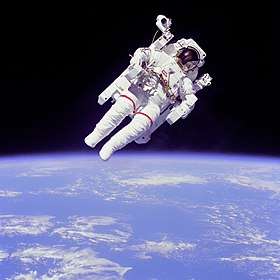 Bruce McCandless demonstrates the Manned Maneuvering Unit (MMU), floating in space above a clouded Earth. | |
| Mission type | Satellite deployment Equipment testing |
|---|---|
| Operator | NASA |
| COSPAR ID | 1984-011A |
| SATCAT no. | 14681 |
| Mission duration | 7 days, 23 hours, 15 minutes, 55 seconds |
| Distance travelled | 5,329,150 kilometres (3,311,380 mi) |
| Orbits completed | 128 |
| Spacecraft properties | |
| Spacecraft | Space Shuttle Challenger |
| Launch mass | 113,603 kilograms (250,452 lb) |
| Landing mass | 91,280 kilograms (201,238 lb) |
| Payload mass | 12,815 kilograms (28,252 lb)[1] |
| Crew | |
| Crew size | 5 |
| Members | |
| EVAs | 2 |
| EVA duration | 12 hours, 12 minutes First: 5 hours, 55 minutes Second: 6 hours, 17 minutes |
| Start of mission | |
| Launch date | February 3, 1984, 13:00:00 UTC |
| Launch site | Kennedy LC-39A |
| End of mission | |
| Landing date | February 11, 1984, 12:15:55 UTC |
| Landing site | Kennedy SLF Runway 15 |
| Orbital parameters | |
| Reference system | Geocentric |
| Regime | Low Earth |
| Perigee altitude | 307 kilometres (166 nmi) |
| Apogee altitude | 317 kilometres (171 nmi) |
| Inclination | 28.5 degrees |
| Period | 90.8 minutes |
| Epoch | February 5, 1984[2] |
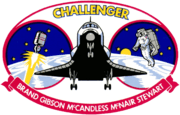 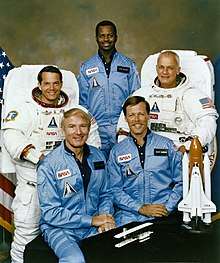 L-R: Seated, Vance Brand, Commander, Robert Gibson, Pilot. Standing, L-R: Mission Specialists Robert L. Stewart, Ronald McNair and Bruce McCandless. Stewart and McCandless are wearing extravehicular mobility units (EMU). | |
Following STS-9, the flight numbering system for the Space Shuttle program was changed. Thus, the next flight, instead of being designated STS-11, became STS-41-B; the original successor to STS-9, STS-10, was cancelled due to payload delays.
Crew
| Position | Astronaut | |
|---|---|---|
| Commander | Vance D. Brand Third spaceflight | |
| Pilot | Robert L. Gibson First spaceflight | |
| Mission Specialist 1 | Bruce McCandless II First spaceflight | |
| Mission Specialist 2 | Robert L. Stewart First spaceflight | |
| Mission Specialist 3 | Ronald E. McNair First spaceflight | |
Spacewalks
- EVA 1
- Personnel: McCandless and Stewart
- Date: February 7, 1984
- Duration: 5 hours, 55 minutes[3]
- EVA 2
- Personnel: McCandless and Stewart
- Date: February 9, 1984
- Duration: 6 hours, 17 minutes[3]
Crew seating arrangements
| Seat[4] | Launch | Landing | 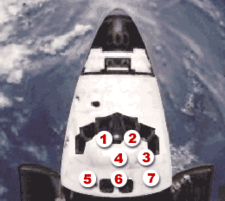 Seats 1–4 are on the Flight Deck. Seats 5–7 are on the Middeck. |
|---|---|---|---|
| S1 | Brand | Brand | |
| S2 | Gibson | Gibson | |
| S3 | McNair | McCandless | |
| S4 | Stewart | Stewart | |
| S5 | McCandless | McNair | |
Mission summary
.jpg)
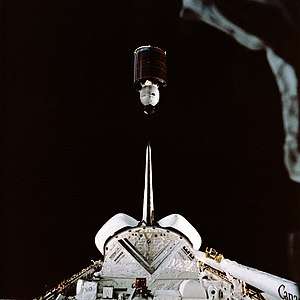
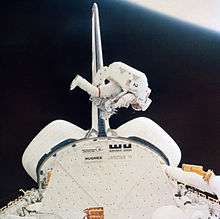
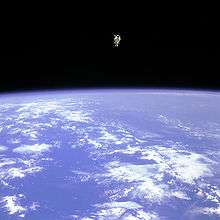
Challenger lifted off from Kennedy Space Center at 8 am EST on February 3, 1984. It was estimated that 100,000 people attended the launch.[5] Two communications satellites were deployed about 8 hours after launch; one, Westar 6, was for America's Western Union, and the other, Palapa B2, for Indonesia.[6] However, the Payload Assist Modules (PAM) for both satellites malfunctioned, placing them into a lower-than-planned orbit. Both satellites were retrieved successfully in November 1984 during STS-51-A, which was conducted by the orbiter Discovery.[6]
The STS-41-B crew included commander Vance D. Brand, making his second Shuttle flight; pilot Robert L. Gibson; and mission specialists Bruce McCandless II, Ronald E. McNair, and Robert L. Stewart.
On the fourth day of the mission, astronauts McCandless and Stewart performed the first untethered spacewalk, operating the Manned Maneuvering Unit (MMU) for the first time.[3][7] McCandless ventured out 320 feet (98 m) from the orbiter, while Stewart tested the "work station" foot restraint at the end of the Remote Manipulator System. On the seventh day of the mission, both astronauts performed another EVA to practice capture procedures for the Solar Maximum Mission satellite retrieval and repair operation, which was planned for the next mission, STS-41-C.[3]
STS-41-B also achieved the reflight of the West German-sponsored SPAS-1 pallet/satellite, which had originally flown on STS-7.[8] This time, however, it remained in the payload bay due to an electrical problem in the RMS. The mission also carried five GAS canisters, six live rats in the middeck area, a Cinema-360 camera and a continuation of the Continuous Flow Electrophoresis System and Monodisperse Latex Reactor experiments.[8] Included in one of the GAS canisters was the first experiment by a high school team to fly in space. The experiment, on seed germination and growth in zero gravity, was created and built by a team from Brighton High School in Utah through a partnership with Utah State University.[8]
The 7-day, 23-hour, 15-minute, 55-second flight ended on February 11, 1984 with a successful landing at Kennedy Space Center's Shuttle Landing Facility. This marked the first landing of a spacecraft at its launch site. Challenger completed 127 orbits and traveled 2.8 million miles.
Mission insignia
Designed by artist Robert McCall, the eleven stars in the blue field symbolize the mission's original designation as STS-11. The left panel shows the deployment of a satellite, and the right panel shows an astronaut using the MMU.
Wake-up calls
NASA began a tradition of playing music to astronauts during the Gemini program, and first used music to wake up a flight crew during Apollo 15. Each track is specially chosen, often by the astronauts' families, and usually has a special meaning to an individual member of the crew, or is applicable to their daily activities.[9]
| Flight Day | Song | Artist/Composer | Played for |
|---|---|---|---|
| Day 2 | Garbled during broadcast, title unknown | Contraband | Ron McNair |
| Day 3 | "A Train" | Contraband | |
| Day 4 | "Glory, Glory, Colorado" | The University of Colorado Band | Vance Brand |
| Day 5 | "Armed Forces Medley" | ||
| Day 6 | "North Carolina A&T University alma mater" "Southern Mississippi to the Top" |
Ron McNair Robert L. Stewart | |
| Day 7 | "Theme from The Greatest American Hero" | Joey Scarbury | |
| Day 8 | "The Air Force Song" | Air Force CAPCOMs | |
| Day 9 | "In the Mood" | Contraband |
After the mission
Astronaut Bruce McCandless later sued a singer over using the public domain photo of him in space on this mission in the 2010s.[10]
Ronald McNair was selected for STS-51-L, which launched on 28 January 1986, but he was killed when Challenger disintegrated nine miles above the Atlantic Ocean 73 seconds after liftoff.[11]
See also
References
![]()
- "NASA shuttle cargo summary" (PDF). NASA. Retrieved August 15, 2015.
- McDowell, Jonathan. "SATCAT". Jonathan's Space Pages. Retrieved March 23, 2014.
- "Feb. 7, 1984: NASA Astronauts Perform First Untethered Spacewalk". New York Times. February 7, 2012. Retrieved July 20, 2013.
- "STS-41B". Spacefacts. Retrieved February 26, 2014.
- Stanley, Rick (February 4, 1984). "Backed Up Cars; Broken Down Bus; a Beautiful Launch". Florida Today. Cocoa, Florida. p. 3A – via Newspapers.com.
- ""It'll Be A Miracle": The Rescue of Palapa and Westar (Part 1)". AmericaSpace. November 12, 2012. Retrieved July 20, 2013.
- ""More Favored than the Birds": The Manned Maneuvering Unit in Space". NASA. 1998. Retrieved July 20, 2013.
- "STS-41-B". Encyclopedia Astronautica. Retrieved July 20, 2013.
- Fries, Colin (June 25, 2007). "Chronology of Wakeup Calls" (PDF). NASA. Retrieved August 13, 2007.
- Michael Zhang (October 8, 2010). "NASA Astronaut Sues Dido Over Album Cover Photograph".
- "Astronaut Bio: Ronald McNair 12/03". jsc.nasa.gov. Archived from the original on March 21, 2009. Retrieved February 7, 2020.
External links
- Mission summary and additional information. NASA.
- STS-41-B video highlights. NSS.
- Bruce McCandelss famous spacewalk NASA channel on YouTube